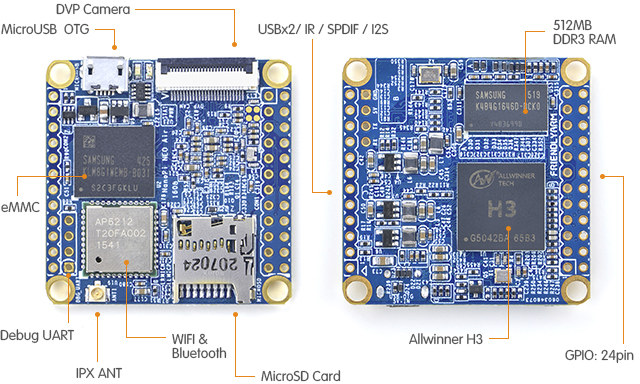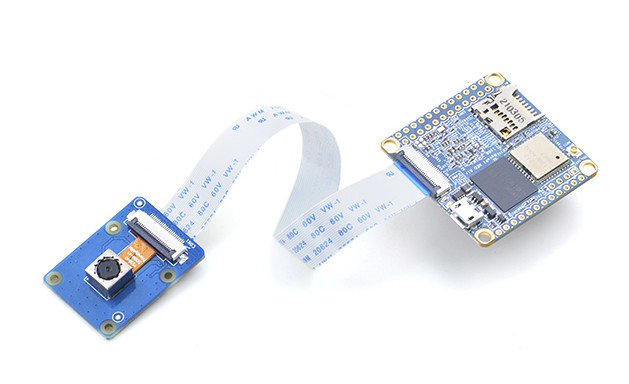FriendlyARM launched NanoPi NEO board with Allwinner H3 processor, Ethernet, and USB ports for $7.99 to $9.99 in July, and the company is back with a new board with the same form factor and processor, by trading Ethernet for WiFi, dropping one USB 2.0 port for a DVP camera interface, and adding an 8GB eMMC flash.
 NanoPi NEO AIR specifications:
NanoPi NEO AIR specifications:
- SoC – Allwinner H3 quad-core Cortex A7 @ 1.2 GHz with an ARM Mali-400MP2 GPU up to 600 MHz
- System Memory – 512 MB DDR3
- Storage – 8GB eMMC Flash (Samsung) + micro SD card slot
- Connectivity – WiFi 802.11 b/g/n and Bluetooth 4.0 LE (via Ampak AP6212 module) with IPEX antenna connector
- USB – 1x micro USB OTG port, 2x USB via headers
- Camera – 1x DVP camera interface with optional 5MP CAM500B camera
- Expansion headers
- 24-pin header with I2C, 2x UART, SPI, PWM, and power signals
- 12-pin header with 2x USB, IR pin, SPDIF, and I2S
- Debugging – 4-pin header for serial console (unpopulated)
- Misc – Power and status LEDs
- Power Supply – 5V/2A via micro USB port or VDD pin on serial header
- Dimensions – 40 x 40 mm
- Weight – 7.5 grams without headers; 9.7 grams with headers
The company provides an Ubuntu Core + Qt firmware image, which will most likely be pre-loaded in the eMMC flash on the board when shipping. More details about hardware and software can be found on the Wiki (English translation in progress).
 As mentioned in the specifications, FriendlyARM will also offer an optional 5-megapixel “CAM500B” camera board that can be connected to the DVP interface of the board. The Wiki shows instructions to stream the video to a web page using mjpg-streamer.
As mentioned in the specifications, FriendlyARM will also offer an optional 5-megapixel “CAM500B” camera board that can be connected to the DVP interface of the board. The Wiki shows instructions to stream the video to a web page using mjpg-streamer.
armbian has also been working on supporting the board, but I’m unclear about the status right now. I’m sure you’ll soon find out by reading the comments’ section of this post.
NanoPi NEO AIR can be purchased for $17.99 with 3 headers, but you may consider adding the heatsink for $2.97, and a 3dB WiFi antenna for $3.99. I could not find CAM500B camera module, but for reference CAM500A camera module (possibly not compatible) is sold for $19.99.

Jean-Luc started CNX Software in 2010 as a part-time endeavor, before quitting his job as a software engineering manager, and starting to write daily news, and reviews full time later in 2011.
Support CNX Software! Donate via cryptocurrencies, become a Patron on Patreon, or purchase goods on Amazon or Aliexpress




